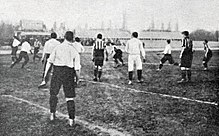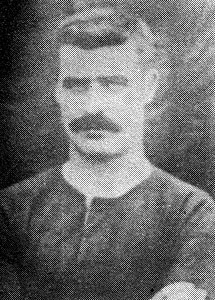CURIOUS FACTS ABOUT FULL INTERNATIONAL AND NATIONAL PLAYERS (1904)
Picture : Ferenc Gillemot, the first coach of Hungary’s national Team (1902 – 1904)
Interesting and curious facts about full internationals and national players (1904)
————————————————————————————————————–by IFFHS—
1904
Hubert Burgess, born in Openshaw (Manchester) on February 25, 1883, started playing with his home town United before joining Glossop and then Manchester City in 1903. From January 1, 1907, to 1910 he played for local rivals Manchester United. “Herbert” Burgess won the English Cup with the “Citizens” in 1904, and was English champion with “ManU” in 1908. From 1904 to 1906 the left full-back played four times for England. Starting with 1910 he went abroad to work as a trainer in Hungary, Spain, Italy, Portugal and Brazil.
—
Over the period of 25 years, Scotland had three national players called John Cameron. The first, a defender, played in 1886 and was with Glasgow Rangers. The second John Cameron (13.4.1872-20.4.1935) was an inside forward with Queen’s Park FC (Glasgow). The third one, another defender, played for Scotland once in 1904 and again in 1909 and was with St. Mirren FC (Paisley) and Chelsea FC (London).
—
Thomas Davies was born in Cefn Mawr (Ruabon) in 1872. In 1890 he transferred from Brockside Villa to Druids FC (Ruabon), the club he would play for until 1910. He had the constitution of a horse and never was injured. From 1898 to 1904 he reached the Welsh Cup final five times with his club, winning it three times. From 1903 to 1904 “Tom” Davies – a half-back turned full-back – played for Wales four times. He was an advocate of total abstinence from both tobacco and alcohol, which he repeatedly and ardently championed in public until his death in the 1950’s.
—
George Henry Davis, born in Alfreton on June 5, 1881, started playing early on for Derby County, but only became a regular during the 1903/04 season. In 1907 the outside left was relegated with the “Rams”. One year later George Henry Davis emigrated to Canada, where he played for Calgary Hillhurst FC, and won the Canadian Cup in 1922. While playing for Derby, he reached the English Cup final in 1903, and in 1904 he played twice for England. The injury-prone wing forward returned to England around 1960, where he lived in Nottingham for the rest of his life.
—
When France played their historic first full “A” international, only 12 players were allowed to travel to Belgium. Leaving Paris at 22:00 on the eve of the match, the team travelled by with the railway through the night and reached Brussels at 4:00 the next day. First, Émile Fontaine or Jacques Davy drew lots to see which of them would get to play. Davy, who actually was better at hockey than football, won. The only player who was not from Paris was outside left Adrien Filez from Tourcoing, the youngest on the team. Making their international début in Vivier d’Oie on May 1, 1904, before a crowd of 1,500 spectators, France drew 3:3. Their first scorer was Louis Mesnier, who played under the pseudonym “Didi”. During the first few years, the French FA (USFSA) preferred players from Paris for the national team and all but ignored good ones in the province.
—
Thomas Bruce Niblo, born in Dunfermline on September 24, 1877, came to Hamilton Academicals from school football and Cadzow Oak. The restless wing forward, who played once for Scotland in 1904, played for Linthouse and Newcastle United (1898-1900), then Aston Villa, Nottingham Forest (1904-1906), then Watford and again Newcastle United (1907/08). “Tommy” Niblo, a good dribbler and quite powerful, was also very good at golf. He sustained permanent injuries during World War I and died in 1933.
—
Dr. Leslie Henderson Skene, born in Lambert (Stirlingshire) on August 22, 1882, attended George Watson’s College in Edinburgh and then Edinburgh University, for which he also played while he was at medical school. Thereafter he joined Queen’s Park (Glasgow), and also played once for Scotland in 1904. He was a casual, calm and not exactly energetic goalkeeper. By profession he was a nephrologist. From 1910 on, his sporting career gradually came to a close in Ireland with Glentoran (Belfast) after he had spent three seasons with Fulham (London).
—
Thomas Parker Sloan, born in Eastwood (Glasgow) on October 4, 1880, played for Thornliebank FC and Glasgow Perthshire before joining Third Lanark in 1900. He was a physically powerful centre-half, big, quick and fearless, with a good grasp of the game around him. By trade he started out as a carpenter, then became a trade school teacher. He was known as “Tod” after a jockey in the USA. His active career, during which he won the Scottish championship in 1904 and the Scottish Cup in 1905, ended in 1913. He later became director of his Glasgow club Third Lanark.
—
On October 9, 1904, Austria entertained Hungary in Vienna. For the past four full internationals, Ferenc Gillemot had been coaching the Hungarian national team. However, he was so distracted that he missed the train and did not join the team – and he had the case which contained the equipment of all the players. Thus the Hungarian team arrived in Vienna without coach, money or kit. The Austrians were generous, however, and helped the Hungarians out. They also won the match (5:4), which was played on the Cricketer field.
—
Alfred Ernest Watkins, born in Llanwnnog (Montgomeryshire) in June 1878, started his footballing career in 1893 with Caersws and Oswestry United before he joined Leicester Fosse (1897-1899), then transferred Aston Villa, did a short stint with Grimsby Town, then joined Millwall Athletic (1901-1906) and finally Southend United. “Ernie” Watkins was the oldest of six footballing brothers, and from 1898 to 1904 already had played for Wales five times. He died in a fire at his house in Barking (Essex), on December 7, 1957. The only one of his brothers who also made the Welsh national team was Walter Martin Watkins (10 matches from 1902 to 1908), who was two years his junior. He started with Caersws and joined Oswestry United in 1894, then played for Stoke FC (1900-1904), Aston Villa, Sunderland (1904/05), Crystal Palace (London), Northampton (1906/07), Stoke FC, Crewe (1908/09), Stafford Rangers and Stoke again FC (1911-1914). Martin Watkins, a small inside forward, dominated on the pitch but was restless and did not settle down off the pitch until 1911. He died in Stoke on May 14, 1942.
Alfred Ernest “Ernie” Watkins Foto: IFFHS
—
Samuel Wolstenholme, born in Little Lever (Lancashire) in March 1876, started out with Farnworth Alliance and played for Horwich before joining Everton FC in 1897. He stayed with them for seven years before transferring to Blackburn Rovers. A right half-back, he played for England three times from 1904 to 1905. His last clubs were Croydon Common (1908/09) and Norwich City (1909-1913). Immediately after concluding his active career, the tricky half-back with the precise passes went to Germany, where after the outbreak of World War I he was unjustly interned for several years just because he was English.


